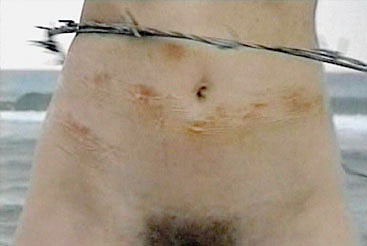
Born in 1969 in Tel-Aviv (IL)
Lives and works in Paris (FR) and Tel-Aviv (IL)

2000
Video, colour, sound
Durée : 2'
Year of Purchase: 2003
The immediate reference that marks the viewer is to religion. The powerful image of a naked Sigalit Landau doing the hula-hoop with a piece of barbed wire on an Israeli beach refers to the sacrificial practices dating back to the origins of religions: rituals, stigmata, propitiations, indelible markings. The Israeli-born artist and performance artist works with the lineage of 1960s and 1970s ceremonial-cathartic Body art as practised by Marina Abramovi?, Gina Pane or the Vienna actionists; the representation of the body profaned, perhaps violently, as a possible expiation for the corruption of contemporary society. But with Sigalit Landau, the pathos inherent in the forms of her elders is here held back by the subversive linking of two antagonistic themes: the profane, rock’n’roll dancing; and the sacred, the icon of sacrifice. Rock my religion. Twist again in Jerusalem. Being used to the spectacular mise en scène (such as that celebratory but tragic parade taking as its subject Andersen’s The Little Prose Seller, in which she turned a concrete mixer into a huge mobile music box;1 or that impressive reconstitution of a terrace in Tel-Aviv from which you could gaze at an infernal postwar orchard2), Sigalit Landau enjoys mixing the painful and the sublime, the graceful and the sordid, naturalism and modernist chaos.
Given her origins, it is not surprising to learn that the artist is sensitive to the notion of borders. With this in mind, the barbed wire is symbolic of the two-way movement (or even the two-edged sword) produced by any setting of geographical boundaries: a figure of both protection and repression (the meadow, the asylum, but also the check-point or the concentration camp). Barbed wire is a metonymy for territorial appropriation, rallying the military and civilians, protect and surrounds while also injuring. Shot in a desert area south of Tel-Aviv, Sigalit Landau’s film thus contrasts the degrading violence of the cultural demarcation line (the one artificially modelled by man) with the natural frontier represented by the sea. In a dangerous dance that leaves its marks, Sigalit Landau demonstrates a moving resistance to oppression, contriving to play with the last vital perimeter left by an astringent political and social space that is a direct threat to the physical integrity of its subjects.
Guillaume Désanges
1 Somnambulin, 2001
2 The Country, 2002